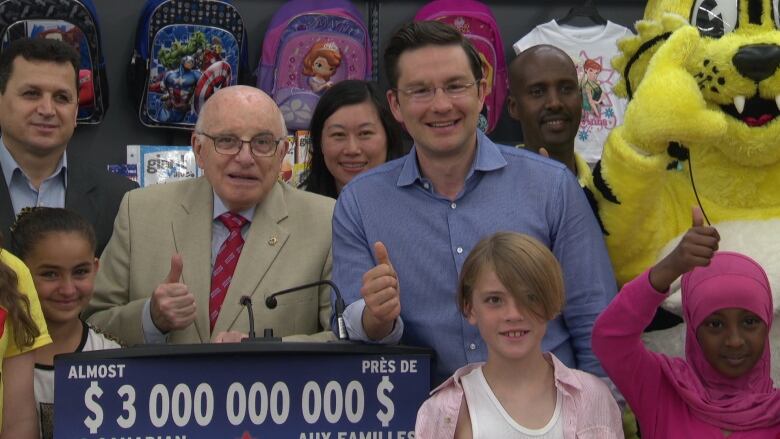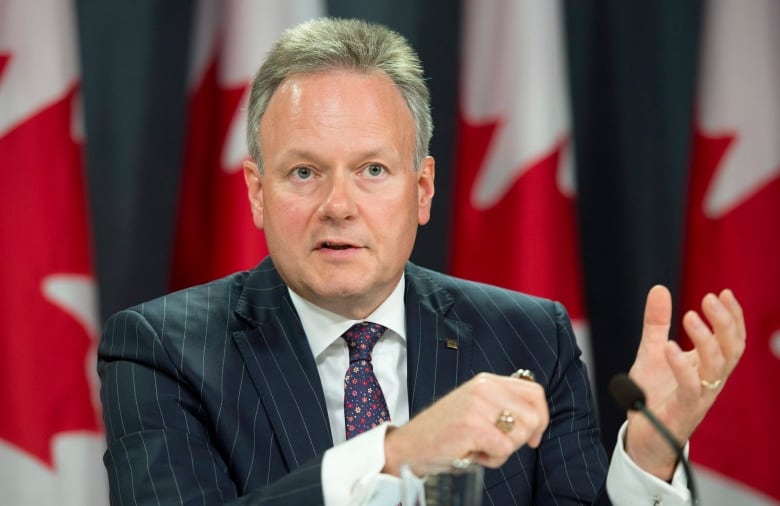3 things to know about the UCCB payments' impact
Conservative MPs were out Monday promoting this week's $3-billion lump-sum payments for the enhanced universal child-care benefit, which the government says will help families and stimulate the economy without negatively affecting the projected budget surplus.
The government announced last fall it would increase the monthly UCCB payment for children under six to $160 from $100, and added a $60 payment for children aged six to 17 effective Jan. 1.
- Poilievre'sshirt choice for promotingUCCBraises eyebrows
- ANALYSIS |Poilievre'shunt to hand out $3B in childcare
- Conservative, suburban ridings gain most from enriched child benefits: CP
Citing the time needed to get the program up and running, the government delivered the first seven months of payments this week, in lump-sum payments of $420 or $520 per child that Employment Minister Pierre Poilievre called "Christmas in July."
But there are caveats. The enhanced UCCB replaces a previous tax credit and it has other tax implications.
We crunched some of the numbers to get a closer look at the impact of the increased UCCB payments.
How much is clawed back?
With the enhanced UCCB, Canadians will receive an extra $720 annually for each child under 18, including the lump-sum payments this week retroactive to the start of the year.
However, on the same day the UCCB came into effect (Jan. 1), the federal government also eliminated an existing child tax credit of $2,255, which was worth $337.50 per child annually in 2015. That change alone wipes out almost half of theUCCB increase for taxpayers.
The UCCB goes to parents of minor children whether they pay tax or not but it is also taxable, both federally and provincially. An Ontario parent earning $50,000, for example, pays income tax at a combined marginal rate of 31.15 per cent. So, with $720 of added income from the UCCB, an additional $224.28 would be clawed back as taxes next year.

Those two factors leave $158.22 a year per child for that Ontario parent, or an additional $13.18 a month net.
The majority of Canadians live in provinces with higher marginal tax rates than Ontario, and would keep even less. People in British Columbia would keep a few cents more than their Ontario counterparts. Higher income earners will keep slightly less of the benefit, while people with low incomes will keep more.
Overall, Canadian parents should expect to keep less than one-third of the nominal amount of the UCCB, and in many cases less than a quarter.
Some parents will also benefit from other recent changes introduced by the Conservatives.
This year, the exemption for child-care expenses increases from $7,000 to $8,000 per child under six, and from $4,000 to $5,000 for older children. So, if an Ontario parent making $50,000 per year has daycare bills over those thresholds, he or she could receive up to an additional $311.50 tax break.
Some families couples who have two incomes in different tax brackets and children under 18 are already getting up to $2,000 from the government's "family tax cut," a non-refundable tax credit announced at the same time as the UCCB increase and effective for the 2014 tax year.
Does the $3B payout threaten the surplus?
The government said it waited to introduce the enhanced UCCB and the family tax cut until the budget was balanced.
But the $1.4 billion federal surplus projected by the spring budget is suddenly under pressure because of a worse-than-expected growth outlook posted last week by the Bank of Canada.
Government coffers will take in about $4 billion less than was expected when the budget was drawn up, according to the outlook. Even with a reserve fund of $1 billion, the bad financial news appears to put the surplus in jeopardy.
The fact the government claws back some of the UCCB increase reduces the program's impact on the federal budget. After accounting for taxes and the end of the child tax credit, the net cost of the UCCB is about half of the $3 billion sent out in cheques this week.
But if the economic downturn does push the budget into a small deficit, some may be tempted to point to this week's massive rollout of payments.
On the other hand, the government continues to insist it will bring in a balanced budget, and it has many ways to shuffle the numbers to achieve that outcome at least on paper.
Will the payments lift the economy?
The Conservative government has billed the cheques as a form of stimulus that will fire up consumer spending and confidence.
How people spend windfalls such as this often depends on their own financial situations.

Typically, wealthier people are more likely to save the money or use it to pay down existing debt. People with lower incomes are more likely to use the money now to meet existing needs, thereby stimulating the economy.
Stephen Poloz, governor of the Bank of Canada, said last week that even though only half of the UCCB money might actually bespent, that would still mean "a noticeable bump in consumption spending in the third quarter" and was a "significant" factor in the bank's outlook.
Some argue no social program can truly be called stimulus, because the money to pay for it has already been removed from the economy in the form of taxes. Economists sometimes describe this as taking water from one end of the pool and pouring it into the other.
And on the flip side, the economy could also see a round of belt-tightening next April, when millions of Canadians file their tax returns and realize belatedly they have to give some of the extra UCCB money back.
Corrections
- This story has been updated to correct a reference that misstated the age ranges for the monthly payments. In fact, children under six are eligible for the $160 monthly payment, while the $60 monthly payment applies to children aged 6 to 17.Jul 22, 2015 12:20 PM ET














_(720p).jpg)


 OFFICIAL HD MUSIC VIDEO.jpg)
.jpg)



























































































